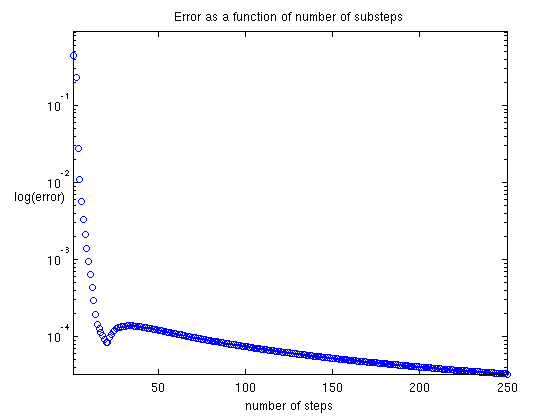Example 2.1: Finite Dimensional Matrices
In this example we consider the system of ordinary differential equations

where the matrix A has complex eigenvalues. To avoid these eigenvalues, we split A into two submatrices A1 and A2 that each have only real eigenvalues and compute an approximate solution based on the operator splitting:
![$$ u_t \approx [ \exp(-\Delta t A_2) \circ \exp(-\Delta t A_1) ]^n u_0. $$](Example2_1_eq26916.png)
Show the matrix and compute eigenvalues
A=[1 2; -2 2]
[R, lambda]=eig(A);
disp('Eigenvalues of A:'), disp(diag(lambda)')
A =
1 2
-2 2
Eigenvalues of A:
1.5000 - 1.9365i 1.5000 + 1.9365i
Split A into A1 and A2
Make a splitting so that the eigenvalues of the two new matrices are real
A1 = [0.5 0; -2 1] [R,lambda1]=eig(A1); disp('Eigenvalues of A1:'), disp(diag(lambda1)') A2 = A-A1 [R,lambda2]=eig(A2); disp('Eigenvalues of A2:'), disp(diag(lambda2)')
A1 =
0.5000 0
-2.0000 1.0000
Eigenvalues of A1:
1.0000 0.5000
A2 =
0.5000 2.0000
0 1.0000
Eigenvalues of A2:
0.5000 1.0000
Investigate accuracy of the splitting
We compute the approximate solution at time T=pi using N splitting steps and report the splitting error as a function of N
T=pi; N=250; u0=[1 1]'; uexact=expm(-T*A)*u0; error=zeros(N,1); for nstep=1:N, usplit=u0; dt=T/nstep; Astep=expm(-dt*A2)*expm(-dt*A1); for i=1:nstep; usplit=Astep*usplit; end; error(nstep)=sum(abs(uexact-usplit)); end; semilogy(error,'o'); title('Error as a function of number of substeps'); axis tight; ylabel('log(error)','Rotation',0); xlabel('number of steps');
